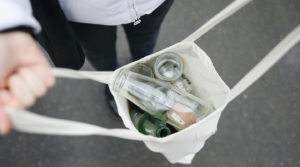Finding ways to enhance the taste of champagne is a challenge that French vintners have embraced for over a thousand years. In the latest twist on this ancient tradition, Yannick Heude of the cellar Abbey Saint-Jean in Saint-Malo has convinced champagne maker Michel Drappier to store some of his wine under the sea. At the beginning of June 2013, six-hundred glass bottles of Drappier Brut Nature champagne were placed under 15 metres of water in the Bay of St Malo where they will remain for the next year.
Heude started his experiments in underwater cellaring during 2004. Each year since, Heude and three colleagues have placed around 600 bottles of wine on the floor of the bay. Red and white wines have been tested with surprisingly good results.
The sea floor has a constant temperature of around 10°C, equal to that of a deep champagne cellar. However, it is the effect of the waves and tides on the glass bottles which accelerate the maturation of the wine. It’s a phenomenon that Scandinavian Akavit producers first noticed when they sent casks of their liquor from Norway to Australia and some accidently came back. The distillers noticed that the flavour of the Akavit had improved dramatically – an effect they put down to the rocking motion of the boat. Today the finest brands of Akavit still make the journey down under and back.
Because the wines Heude tests are stored in glass bottles, it is easy to compare the effect of storing the wine under water with cellared. Essentially it is the same wine in the same packaging, only the storage conditions are different. The glass prevents any contaminants from air or the sea water entering the wine, and is robust enough to withstand the effect of the underwater currents.
“It’s incredible!” says Heude. “We never imagined there would be such a difference in taste between the submerged bottles, and those that remained in the cellar. The nose was more powerful, more aromatic, more fruity while the mouth had more volume, more aroma, and ended with a fresh and mineral sensation.” The Drappier Brut Nature will be raised to the surface in June 2014 when it’s hoped the tasting will prove just as successful as in previous years.





